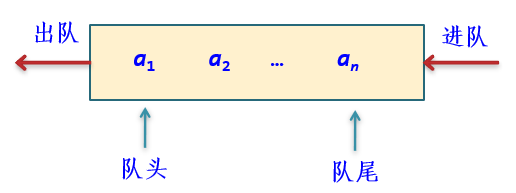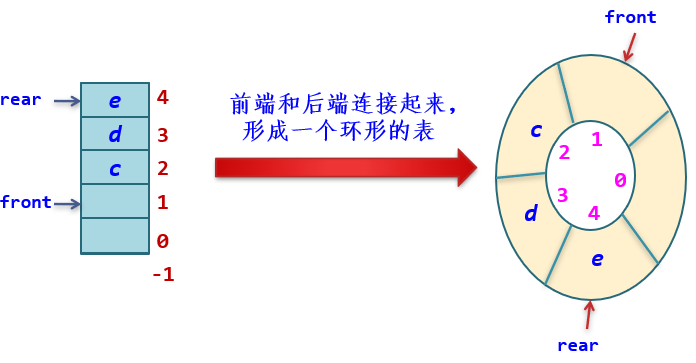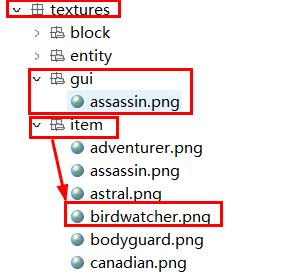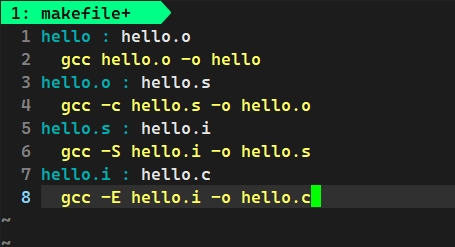第1关:循环队列的基本操作
任务描述
本关任务是实现循环队列的基本操作函数,以实现判断队列是否为满、是否为空、求队列元素个数、进队和出队等功能。
相关知识
队列的基本概念
队列(简称队)也是一种运算受限的线性表,在这种线性表上,插入限定在表的某一端进行,删除限定在表的另一端进行。
队列的插入操作称为进队,删除操作称为出队。
允许插入的一端称为队尾,允许删除的一端称为队头。
新插入的元素只能添加到队尾,被删除的只能是排在队头的元素。
一个队列的示意图:

队列通常有两种存储结构,即顺序存储结构和链式存储结构。
队列的顺序存储结构简称为顺序队列,它由一个一维数组(用于存储队列中元素)及两个分别指示队头和队尾的变量组成,这两个变量分别称为“队头指针”和“队尾指针”。
通常约定队尾指针指示队尾元素的当前位置,队头指针指示队头元素的前一个位置。
循环队列的类型定义
#define MAX_QSIZE 5 // 最大队列长度+1struct SqQueue{ QElemType *base; // 初始化的动态分配存储空间 int front; // 头指针,若队列不空,指向队列头元素 int rear; // 尾指针,若队列不空,指向队列尾元素的下一个位置};使用顺序队列时会出现“假溢出现象”,为了能够充分地使用数组中的存储空间,可以把数组的前端和后端连接起来,形成一个环形的表,即把存储队列元素的表从逻辑上看成一个环。这个环形的表叫做循环队列。
一个循环队列示意图:

队头队尾指针进1的操作为:
队头指针进1:front=(front+1) MOD MaxSize
队尾指针进1:rear=(rear+1) MOD MaxSize
为了在循环队列中区分队空和队满,规定:
设置队空条件为front==rear。
设置队满条件为(rear+1) MOD MaxSize==front。也就是说,当rear指到front的前一位置时就认为队列满了。
显然在这样设置的队满条件下,队满条件成立时队中还有一个空闲单元,也就是说这样的队中最多只能进队MaxSize-1个元素。
编程要求
根据提示,在右侧编辑器补充代码,编写循环队列的基本操作函数。
void InitQueue(SqQueue &Q); // 构造一个空队列Q
void DestroyQueue(SqQueue &Q); // 销毁队列Q,Q不再存在
void ClearQueue(SqQueue &Q); // 将Q清为空队列
int QueueEmpty(SqQueue Q); // 若队列Q为空队列,则返回TRUE;否则返回FALSE
int QueueLength(SqQueue Q); // 返回Q的元素个数,即队列的长度
int GetHead(SqQueue Q,QElemType &e); // 若队列不空,则用e返回Q的队头元素,并返回OK;否则返回ERROR
int EnQueue(SqQueue &Q,QElemType e); // 插入元素e为Q的新的队尾元素
int DeQueue(SqQueue &Q,QElemType &e); // 若队列不空,则删除Q的队头元素,用e返回其值,并返回OK;否则返回ERROR
void QueueTraverse(SqQueue Q,void(*vi)(QElemType)); // 从队头到队尾依次对队列Q中每个元素调用函数vi() 测试说明
平台会对你编写的代码进行测试:
测试输入:
10 20 30 40 50
60
预期输出:
队列长度为: 4
现在队列中元素:
10 20 30 40
删除的元素是10
删除的元素是20
队列长度为: 3
现在队列中元素:
30 40 60
现在队头元素为:30
开始你的任务吧,祝你成功!
代码示例
#include <stdio.h>
#include<stdlib.h>
#include <iostream>
using namespace std;// 函数结果状态代码
#define TRUE 1
#define FALSE 0
#define OK 1
#define ERROR 0
#define OVERFLOW -1
typedef int QElemType;#define MAX_QSIZE 5 // 最大队列长度+1struct SqQueue
{QElemType *base; // 初始化的动态分配存储空间int front; // 头指针,若队列不空,指向队列头元素int rear; // 尾指针,若队列不空,指向队列尾元素的下一个位置
};void print(QElemType i)
{printf("%d ",i);
}
void InitQueue(SqQueue &Q); // 构造一个空队列Q
void DestroyQueue(SqQueue &Q); // 销毁队列Q,Q不再存在
void ClearQueue(SqQueue &Q); // 将Q清为空队列
int QueueEmpty(SqQueue Q); // 若队列Q为空队列,则返回TRUE;否则返回FALSE
int QueueLength(SqQueue Q); // 返回Q的元素个数,即队列的长度
int GetHead(SqQueue Q,QElemType &e); // 若队列不空,则用e返回Q的队头元素,并返回OK;否则返回ERROR
int EnQueue(SqQueue &Q,QElemType e); // 插入元素e为Q的新的队尾元素
int DeQueue(SqQueue &Q,QElemType &e); // 若队列不空,则删除Q的队头元素,用e返回其值,并返回OK;否则返回ERROR
void QueueTraverse(SqQueue Q,void(*vi)(QElemType)); // 从队头到队尾依次对队列Q中每个元素调用函数vi() int main()
{int j;int i=0,l;QElemType d;SqQueue Q;InitQueue(Q);for(i=0;i<MAX_QSIZE;i++){scanf("%d",&d); EnQueue(Q,d);};printf("队列长度为: %d\n",QueueLength(Q));printf("现在队列中元素:\n");QueueTraverse(Q,print);DeQueue(Q,d);printf("删除的元素是%d\n",d);DeQueue(Q,d);printf("删除的元素是%d\n",d);scanf("%d",&d);EnQueue(Q,d);printf("队列长度为: %d\n",QueueLength(Q));printf("现在队列中元素:\n");QueueTraverse(Q,print);j=GetHead(Q,d);if(j)printf("现在队头元素为:%d\n",d);ClearQueue(Q);DestroyQueue(Q);
}
// 循环队列的基本操作(9个)
void InitQueue(SqQueue &Q)
{ // 构造一个空队列Q/********** Begin **********/ Q.base = new QElemType[MAX_QSIZE];if(!Q.base) exit(OVERFLOW); // 存储分配失败Q.front = Q.rear = 0;/********** End **********/
}void DestroyQueue(SqQueue &Q)
{ // 销毁队列Q,Q不再存在/********** Begin **********/ free(Q.base);Q.base=NULL;Q.front=Q.rear=0;/********** End **********/
}void ClearQueue(SqQueue &Q)
{ // 将Q清为空队列/********** Begin **********/ Q.front=Q.rear=0;/********** End **********/
}int QueueEmpty(SqQueue Q)
{ // 若队列Q为空队列,则返回TRUE;否则返回FALSE/********** Begin **********/ if(Q.front==Q.rear)return TRUE;elsereturn FALSE;/********** End **********/ }int QueueLength(SqQueue Q)
{ // 返回Q的元素个数,即队列的长度/********** Begin **********/ return (Q.rear-Q.front+MAX_QSIZE)%MAX_QSIZE;/********** End **********/ }int GetHead(SqQueue Q,QElemType &e){ // 若队列不空,则用e返回Q的队头元素,并返回OK;否则返回ERROR/********** Begin **********/ if(Q.front==Q.rear) // 队列空return ERROR;e=Q.base[Q.front];return OK;/********** End **********/
}int EnQueue(SqQueue &Q,QElemType e)
{ // 插入元素e为Q的新的队尾元素/********** Begin **********/ if((Q.rear+1)%MAX_QSIZE==Q.front)return ERROR;Q.base[Q.rear]=e;Q.rear=(Q.rear+1)%MAX_QSIZE;return OK;/********** End **********/ }int DeQueue(SqQueue &Q,QElemType &e)
{ // 若队列不空,则删除Q的队头元素,用e返回其值,并返回OK;否则返回ERROR/********** Begin **********/ if(Q.front==Q.rear)return ERROR;e=Q.base[Q.front];Q.front=(Q.front+1)%MAX_QSIZE;return OK;/********** End **********/
}void QueueTraverse(SqQueue Q,void(*vi)(QElemType))
{ // 从队头到队尾依次对队列Q中每个元素调用函数vi()/********** Begin **********/ int i=Q.front;while(i!=Q.rear){vi(Q.base[i]);i=(i+1)%MAX_QSIZE;}printf("\n");/********** End **********/
}第2关:链队列的基本操作
任务描述
本关任务是实现链队列的基本操作函数,以实现判断队列是否为满、是否为空、求队列元素个数、进队和出队等功能。
相关知识
链队列的基本概念
队列的链式存储结构简称为链队列。
这里采用的链队是一个同时带有队头指针front和队尾指针rear的单链表。
队头指针指向队头结点,队尾指针指向队尾结点即单链表的尾结点,并将队头和队尾指针结合起来构成链队结点,
链队列逻辑示意图:

下面给出一种链队列的实现方案。
链队列的类型定义
typedef struct QNode
{QElemType data;QNode *next;
}*QueuePtr;
struct LinkQueue
{QueuePtr front,rear; // 队头、队尾指针
};编程要求
根据提示,在右侧编辑器补充代码,编写链队列的基本操作函数。
void InitQueue(LinkQueue &Q); // 构造一个空队列Q
void DestroyQueue(LinkQueue &Q); // 销毁队列Q,Q不再存在
void ClearQueue(LinkQueue &Q); // 将Q清为空队列
int QueueEmpty(LinkQueue Q); // 若队列Q为空队列,则返回TRUE;否则返回FALSE
int QueueLength(LinkQueue Q); // 返回Q的元素个数,即队列的长度
int GetHead(LinkQueue Q,QElemType &e); // 若队列不空,则用e返回Q的队头元素,并返回OK;否则返回ERROR
int EnQueue(LinkQueue &Q,QElemType e); // 插入元素e为Q的新的队尾元素
int DeQueue(LinkQueue &Q,QElemType &e); // 若队列不空,则删除Q的队头元素,用e返回其值,并返回OK;否则返回ERROR
void QueueTraverse(LinkQueue Q,void(*vi)(QElemType)); // 从队头到队尾依次对队列Q中每个元素调用函数vi() 测试说明
平台会对你编写的代码进行测试:
测试输入:
10 20 30 40 50
60
预期输出:
队列长度为: 5
`现在队列中元素:
10 20 30 40 50
删除的元素是10
`删除的元素是20
队列长度为: 4
现在队列中元素:
30 40 50 60
现在队头元素为:30
开始你的任务吧,祝你成功!
代码示例
#include <stdio.h>
#include<stdlib.h>
#include <iostream>
using namespace std;// 函数结果状态代码#define TRUE 1#define FALSE 0#define OK 1#define ERROR 0 #define OVERFLOW -1typedef int QElemType;typedef struct QNode
{QElemType data;QNode *next;
}*QueuePtr;
struct LinkQueue
{QueuePtr front,rear; // 队头、队尾指针
};void print(QElemType i)
{printf("%d ",i);
}
void InitQueue(LinkQueue &Q); // 构造一个空队列Q
void DestroyQueue(LinkQueue &Q); // 销毁队列Q,Q不再存在
void ClearQueue(LinkQueue &Q); // 将Q清为空队列
int QueueEmpty(LinkQueue Q); // 若队列Q为空队列,则返回TRUE;否则返回FALSE
int QueueLength(LinkQueue Q); // 返回Q的元素个数,即队列的长度
int GetHead(LinkQueue Q,QElemType &e); // 若队列不空,则用e返回Q的队头元素,并返回OK;否则返回ERROR
int EnQueue(LinkQueue &Q,QElemType e); // 插入元素e为Q的新的队尾元素
int DeQueue(LinkQueue &Q,QElemType &e); // 若队列不空,则删除Q的队头元素,用e返回其值,并返回OK;否则返回ERROR
void QueueTraverse(LinkQueue Q,void(*vi)(QElemType)); // 从队头到队尾依次对队列Q中每个元素调用函数vi() int main()
{int j;int i=0,l;QElemType d;LinkQueue Q;InitQueue(Q);for(i=0;i<5;i++){scanf("%d",&d); EnQueue(Q,d);};printf("队列长度为: %d\n",QueueLength(Q));printf("现在队列中元素:\n");QueueTraverse(Q,print);DeQueue(Q,d);printf("删除的元素是%d\n",d);DeQueue(Q,d);printf("删除的元素是%d\n",d);scanf("%d",&d);EnQueue(Q,d);printf("队列长度为: %d\n",QueueLength(Q));printf("现在队列中元素:\n");QueueTraverse(Q,print);j=GetHead(Q,d);if(j)printf("现在队头元素为:%d\n",d);ClearQueue(Q);DestroyQueue(Q);}
// 链队列的基本操作(9个)
void InitQueue(LinkQueue &Q){ // 构造一个空队列Q/********** Begin **********/ Q.front=Q.rear=(QueuePtr)malloc(sizeof(QNode));if(!Q.front) exit(OVERFLOW);Q.front->next=NULL;/********** End **********/
}void DestroyQueue(LinkQueue &Q)
{ // 销毁队列Q(无论空否均可)/********** Begin **********/ while(Q.front){Q.rear=Q.front->next;free(Q.front);Q.front=Q.rear;}/********** End **********/
}void ClearQueue(LinkQueue &Q)
{ // 将Q清为空队列/********** Begin **********/ QueuePtr p=Q.front,q;Q.front=Q.rear;while(p->next!=NULL){q=p;p=p->next;free(q);}/********** End **********/ }int QueueEmpty(LinkQueue Q){ // 若Q为空队列,则返回TRUE,否则返回FALSE/********** Begin **********/ if(Q.front->next==NULL)return TRUE;elsereturn FALSE;/********** End **********/
}int QueueLength(LinkQueue Q)
{ // 求队列的长度/********** Begin **********/ QueuePtr p=Q.front;int i=0;while(p!=Q.rear){i++;p=p->next;}return i;/********** End **********/
}int GetHead(LinkQueue Q,QElemType &e)
{ // 若队列不空,则用e返回Q的队头元素,并返回OK,否则返回ERROR/********** Begin **********/ QueuePtr p;if(Q.front==Q.rear)return ERROR;p=Q.front->next;e=p->data;return OK;/********** End **********/ }int EnQueue(LinkQueue &Q,QElemType e)
{ // 插入元素e为Q的新的队尾元素/********** Begin **********/ QueuePtr p=(QueuePtr)malloc(sizeof(QNode));if(!p) exit(OVERFLOW);p->data=e;p->next=NULL;Q.rear->next=p;Q.rear=p;/********** End **********/
}int DeQueue(LinkQueue &Q,QElemType &e)
{ // 若队列不空,删除Q的队头元素,用e返回其值,并返回OK,否则返回ERROR/********** Begin **********/ QueuePtr p;if(Q.front==Q.rear)return ERROR;p=Q.front->next;e=p->data;Q.front->next=p->next;if(Q.rear==p)Q.rear=Q.front;free(p);return OK;/********** End **********/
}void QueueTraverse(LinkQueue Q,void(*vi)(QElemType))
{ // 从队头到队尾依次对队列Q中每个元素调用函数vi()/********** Begin **********/ QueuePtr p=Q.front->next;while(p!=NULL){vi(p->data);p=p->next;}printf("\n");/********** End **********/ }




